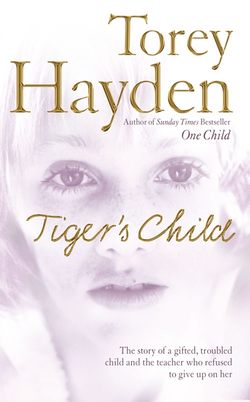Читать книгу The Tiger’s Child: The story of a gifted, troubled child and the teacher who refused to give up on her - Torey Hayden, Torey Hayden - Страница 5
Prologue
ОглавлениеIt was a moment of déjà vu.
Home in Montana visiting my mother, I had nipped out alone on a Sunday morning while she and my young daughter went swimming. It was just after eleven and I was walking through the shopping mall. Most of the stores weren’t open yet, and as a consequence, the broad concourse was shadowy, illuminated only by security lighting.
Suddenly I saw her. Some distance ahead of me down the mall, she was standing in the shadows of a large planter. Long, unkempt hair tumbled down over her shoulders; bangs hung into her eyes; thick, sensual lips were pushed out in a dramatic pout. She stood with arms crossed tightly over her chest, her shoulders pulled up, her face set in an expression of fierce defiance; and yet there was a poignancy about all that fierceness. I suspect she already knew she wasn’t going to win. I was well down the mall when I first saw her, but I recognized her so instantly that adrenaline shot through my veins. Sheila.
A second or two later my intellect caught up. It wasn’t Sheila, of course. More than twenty years have passed since I watched Sheila depart from my classroom on that warm June afternoon. I am no longer the angry young teacher I was. My teaching days are, at least for the time being, behind me and I have exchanged youth—with some reluctance—for middle age. Yet, for those brief few minutes in the shopping mall, the years disappeared. I was pulled back into the seventies, into my workaholic twenties, to feel once again, however fleetingly, the person I had been and the world as it was then.
Then reality began to impose, layering itself down over the incident rather the way one lays a transparency down over a page. I approached the girl with curiosity, drew up even with her and paused, feigning interest in a nearby shop window so that I could unobtrusively study her. She was older than Sheila had been. She was perhaps seven or even eight. Her hair was darker, more mouse-brown than blond.
My nearness didn’t put off her anger any. I was a stranger, so she ignored me and concentrated all her attention on the open doorway of the huge department store behind me. I couldn’t discern who had upset her so. They had disappeared into the store, but she stood on, her small fists clenched, her tousled hair falling forward, her hopeless, helpless anger emanating from her. Anonymous and silent, I remained where I was, half a dozen feet away, and marveled at how such a small encounter could wipe away so many years, how Sheila could still set my heart beating fast.
Sheila and I, as student and teacher, were only together for five months. Our relationship over that short time evoked dramatic changes in Sheila’s behavior and vastly altered the course of her life. Although less obvious at the time, our relationship also dramatically changed me and vastly altered the course of my life too. This little girl had a profound effect on me. Her courage, her resilience and her inadvertent ability to express that great, gaping need to be loved that we all feel—in short, her humanness—brought me into contact with my own.
The five months Sheila was in my class I chronicled in One Child. It was a private book, never initially written with the intention of publication, but only as my own effort to understand more fully this deeply felt relationship. I was teaching a university graduate class in special education at the time and it is to a student in that class that I owe my thanks. The last day of class she gave me a copy of Ron Jones’s The Acorn People, and inscribed it in the front: To Torey, in hopes that someday you might write about Sheila, Leslie and all the others.
One Child now spans the world in twenty-two languages and has brought me into contact with individuals from Sweden to South Africa, from New York to Singapore. One reader wrote from a base in Antarctica; a handful of letters came from behind the Iron Curtain before it fell; and I have just recently received my first correspondence over One Child from mainland China. The universal appeal of watching Sheila grow and change has only been matched by one thing, a question: What happened next?
One Child is a true story, based on real people and real people’s experiences. I hesitated to write a sequel simply because six-year-old Sheila was so appealing and the period we spent together was so positive. Indeed, my One Child editor went so far as to suggest I not include in the epilogue of the book what had actually been happening to Sheila in the time since we had parted. Real lives are seldom as satisfying as fiction, or even as satisfying as judiciously edited nonfiction, and it was felt the interim period between my class and the time I wrote One Child would make too grim an ending for such an upbeat story. Thus, the book concluded with Sheila’s beautiful poem, but no details.
I’ve now changed my mind, not only in response to the countless queries from my readers, but also in response to Sheila, who, against remarkable odds, has grown into an engaging, articulate young woman. Those five months we spent together did have a profound effect on her, but One Child, although I hadn’t meant it to, tells my story. The experience for Sheila was quite a different one and here, to quote Paul Harvey, is the rest of the story.
